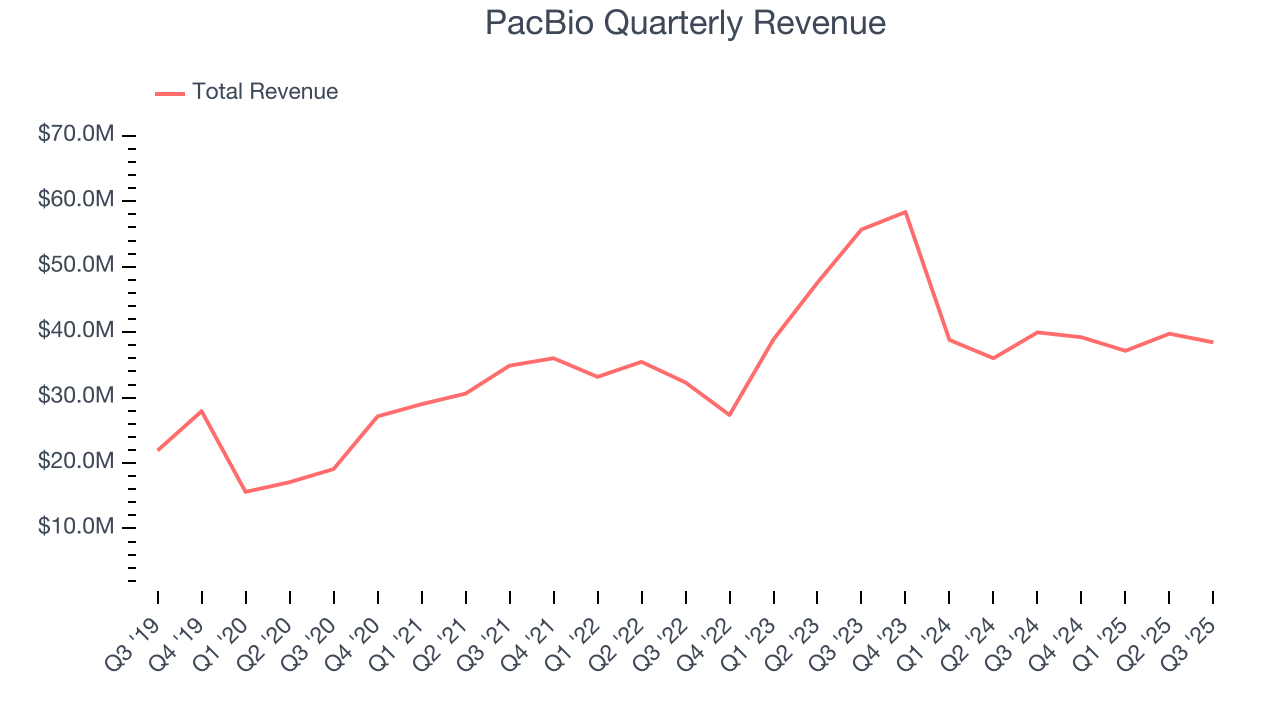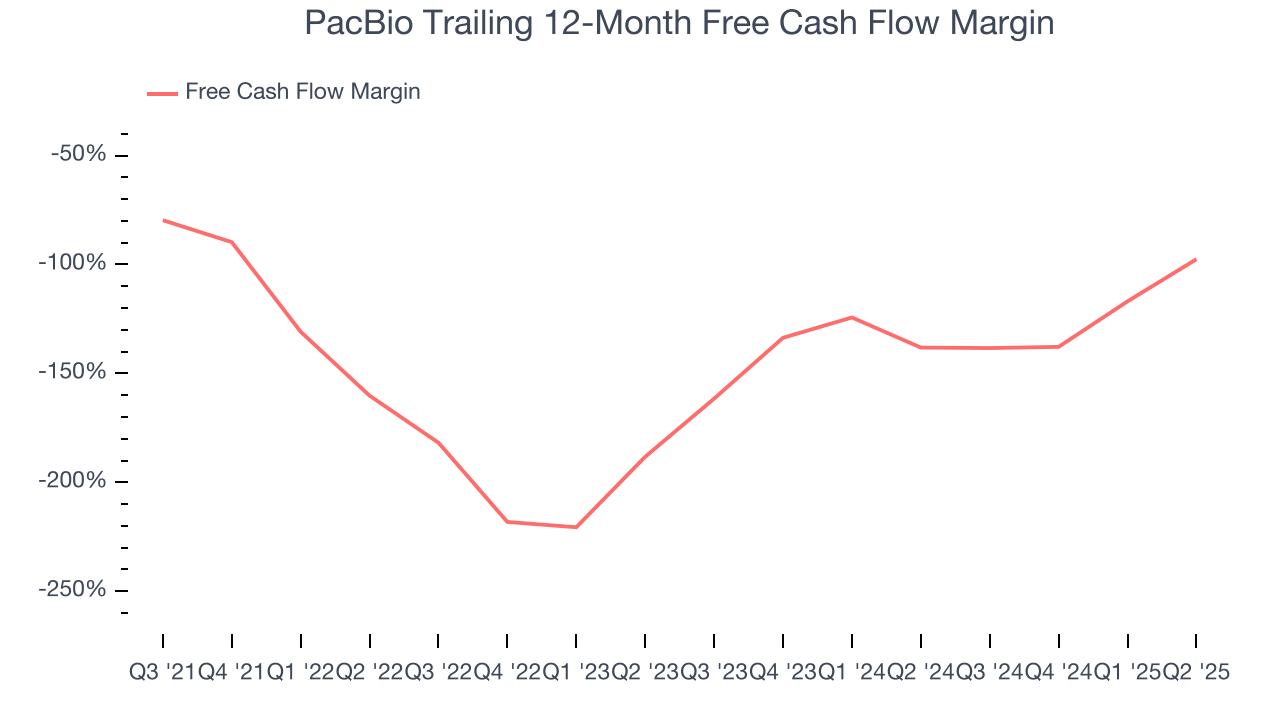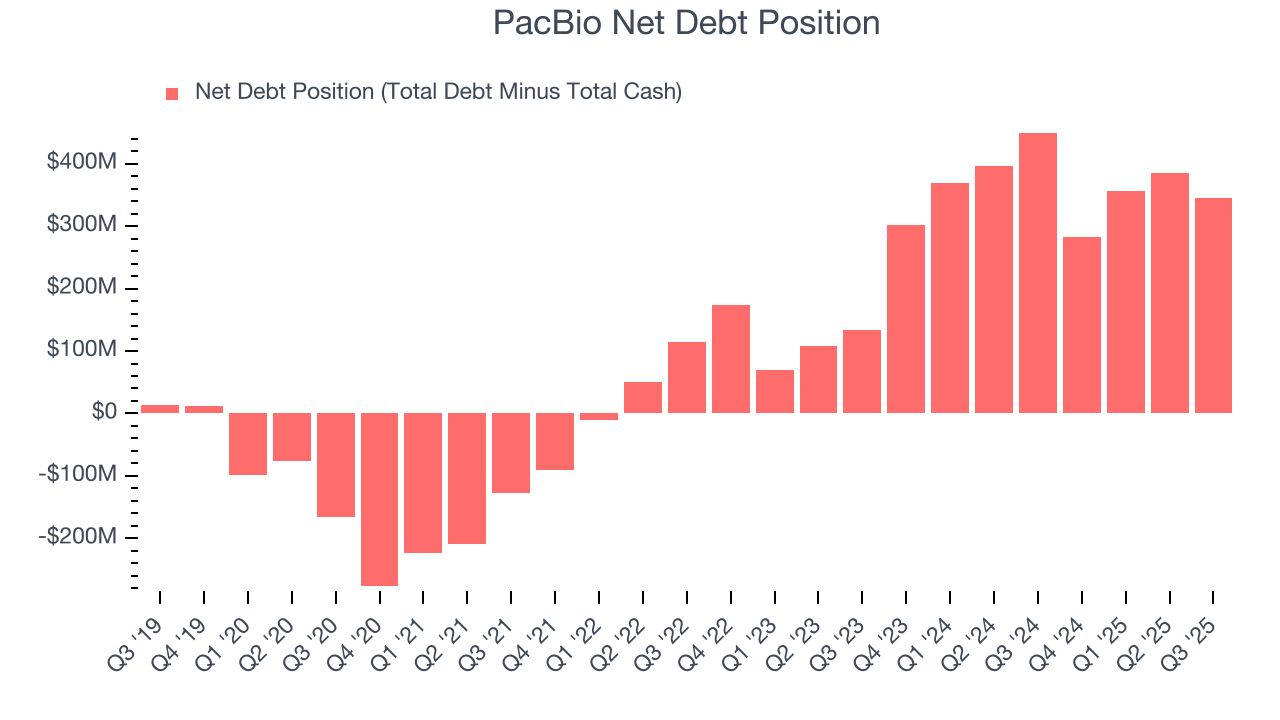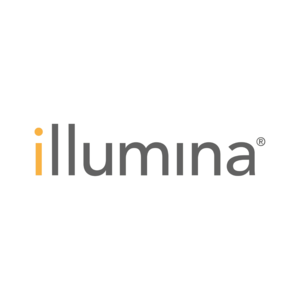
PacBio (PACB)
PacBio is up against the odds. Its sales have recently flopped and its historical cash burn means it has few resources to reignite growth.― StockStory Analyst Team
1. News
2. Summary
Why We Think PacBio Will Underperform
Pioneering what scientists call "HiFi long-read sequencing," recognized as Nature Methods' method of the year for 2022, Pacific Biosciences (NASDAQ:PACB) develops advanced DNA sequencing systems that enable scientists and researchers to analyze genomes with unprecedented accuracy and completeness.
- Historical adjusted operating margin losses point to an inefficient cost structure
- Cash burn has widened over the last five years, making us question whether it can reliably generate shareholder value
- Negative EBITDA restricts its access to capital and increases the probability of shareholder dilution if things turn unexpectedly


PacBio doesn’t live up to our standards. Better businesses are for sale in the market.
Why There Are Better Opportunities Than PacBio
High Quality
Investable
Underperform
Why There Are Better Opportunities Than PacBio
PacBio is trading at $2.44 per share, or 4.1x forward price-to-sales. The market typically values companies like PacBio based on their anticipated profits for the next 12 months, but it expects the business to lose money. We also think the upside isn’t great compared to the potential downside here - there are more exciting stocks to buy.
We’d rather pay up for companies with elite fundamentals than get a decent price on a poor one. High-quality businesses often have more durable earnings power, helping us sleep well at night.
3. PacBio (PACB) Research Report: Q3 CY2025 Update
Genomics company Pacific Biosciences of California (NASDAQ:PACB) fell short of the markets revenue expectations in Q3 CY2025, with sales falling 3.8% year on year to $38.44 million. Its non-GAAP loss of $0.12 per share was 14.2% above analysts’ consensus estimates.
PacBio (PACB) Q3 CY2025 Highlights:
- Revenue: $38.44 million vs analyst estimates of $40.24 million (3.8% year-on-year decline, 4.5% miss)
- Adjusted EPS: -$0.12 vs analyst estimates of -$0.14 (14.2% beat)
- Adjusted EBITDA: -$38.04 million vs analyst estimates of -$38.36 million (-99% margin, 0.8% beat)
- Operating Margin: -101%, up from -160% in the same quarter last year
- Market Capitalization: $600.7 million
Company Overview
Pioneering what scientists call "HiFi long-read sequencing," recognized as Nature Methods' method of the year for 2022, Pacific Biosciences (NASDAQ:PACB) develops advanced DNA sequencing systems that enable scientists and researchers to analyze genomes with unprecedented accuracy and completeness.
Pacific Biosciences' technology allows researchers to read longer stretches of DNA with high accuracy, solving problems that shorter-read technologies struggle with. The company offers two main sequencing approaches: its flagship HiFi long-read technology based on Single-Molecule Real-Time (SMRT) sequencing, and its newer Sequencing by Binding (SBB) short-read technology.
The company's product portfolio includes sequencing instruments like the Revio and Onso systems, along with consumables such as SMRT Cells, flow cells, and reagent kits that customers need to prepare and analyze DNA samples. For example, a cancer researcher might use Pacific Biosciences' technology to identify complex structural variations in tumor DNA that other sequencing methods might miss, potentially revealing new therapeutic targets.
Pacific Biosciences serves a diverse customer base including academic institutions, government research labs, pharmaceutical companies, agricultural businesses, and clinical research organizations. These customers use the company's technology for applications ranging from human genetics and cancer research to plant breeding and infectious disease studies.
The company generates revenue through instrument sales and the ongoing purchase of consumables needed for each sequencing run. This creates a razor-and-blade business model, where initial instrument placement leads to recurring revenue from consumables. Pacific Biosciences also continues to innovate, as evidenced by its 2023 acquisition of Apton Biosystems to accelerate development of high-throughput sequencing platforms and the launch of its Kinnex product line for optimizing RNA sequencing.
4. Genomics & Sequencing
Genomics and sequencing companies within the life sciences industry provide the technology for increasingly personalized medicine, drug discovery, and disease research. These firms leverage cutting-edge platforms for high-throughput sequencing and genomic analysis, enabling researchers and healthcare providers to better understand genetic underpinnings of diseases. While the industry enjoys high barriers to entry due to proprietary technology and intellectual property, the business model also faces significant R&D costs, reliance on continued innovation, and exposure to shifts in academic, biotech, and clinical research funding. Over the next few years, the subsector is well-positioned to benefit from tailwinds such as increasing adoption of precision medicine, expanded applications for sequencing technologies in areas like oncology and rare disease diagnostics, and growing use of genomic data in drug development. Advances in artificial intelligence could further enhance the speed and accuracy of genomic insights. However, potential headwinds include price sensitivity among research institutions and healthcare systems that are constantly trying to contain and lower costs. Additionally, regulations around data privacy and genomic testing are not yet set in stone, adding uncertainty to the industry.
Pacific Biosciences competes with other DNA sequencing technology providers, primarily Illumina (NASDAQ:ILMN), which dominates the short-read sequencing market, Oxford Nanopore Technologies (LSE:ONT), which offers portable long-read sequencing solutions, and Element Biosciences, a private company focused on affordable, high-quality sequencing.
5. Revenue Scale
Larger companies benefit from economies of scale, where fixed costs like infrastructure, technology, and administration are spread over a higher volume of goods or services, reducing the cost per unit. Scale can also lead to bargaining power with suppliers, greater brand recognition, and more investment firepower. A virtuous cycle can ensue if a scaled company plays its cards right.
With just $154.6 million in revenue over the past 12 months, PacBio is a tiny company in an industry where scale matters. This makes it difficult to succeed because healthcare is heavily regulated, complex, and resource-intensive.
6. Revenue Growth
A company’s long-term sales performance can indicate its overall quality. Any business can put up a good quarter or two, but many enduring ones grow for years. Thankfully, PacBio’s 14.2% annualized revenue growth over the last five years was solid. Its growth beat the average healthcare company and shows its offerings resonate with customers.

We at StockStory place the most emphasis on long-term growth, but within healthcare, a half-decade historical view may miss recent innovations or disruptive industry trends. PacBio’s recent performance marks a sharp pivot from its five-year trend as its revenue has shown annualized declines of 4.5% over the last two years. 
This quarter, PacBio missed Wall Street’s estimates and reported a rather uninspiring 3.8% year-on-year revenue decline, generating $38.44 million of revenue.
Looking ahead, sell-side analysts expect revenue to grow 14.6% over the next 12 months, an improvement versus the last two years. This projection is commendable and implies its newer products and services will catalyze better top-line performance.
7. Operating Margin
Operating margin is an important measure of profitability as it shows the portion of revenue left after accounting for all core expenses – everything from the cost of goods sold to advertising and wages. It’s also useful for comparing profitability across companies with different levels of debt and tax rates because it excludes interest and taxes.
PacBio’s high expenses have contributed to an average operating margin of negative 246% over the last five years. Unprofitable healthcare companies require extra attention because they could get caught swimming naked when the tide goes out. It’s hard to trust that the business can endure a full cycle.
Analyzing the trend in its profitability, PacBio’s operating margin decreased significantly over the last five years. The company’s two-year trajectory also shows it failed to get its profitability back to the peak as its margin fell by 232.8 percentage points. This performance was poor no matter how you look at it - it shows its expenses were rising and it couldn’t pass those costs onto its customers.

In Q3, PacBio generated a negative 101% operating margin.
8. Earnings Per Share
Revenue trends explain a company’s historical growth, but the long-term change in earnings per share (EPS) points to the profitability of that growth – for example, a company could inflate its sales through excessive spending on advertising and promotions.
PacBio’s full-year EPS was flat over the last five years. This performance was underwhelming across the board.

In Q3, PacBio reported adjusted EPS of negative $0.12, up from negative $0.17 in the same quarter last year. This print easily cleared analysts’ estimates, and shareholders should be content with the results. Over the next 12 months, Wall Street expects PacBio to improve its earnings losses. Analysts forecast its full-year EPS of negative $0.60 will advance to negative $0.51.
9. Cash Is King
If you’ve followed StockStory for a while, you know we emphasize free cash flow. Why, you ask? We believe that in the end, cash is king, and you can’t use accounting profits to pay the bills.
PacBio’s demanding reinvestments have drained its resources over the last five years, putting it in a pinch and limiting its ability to return capital to investors. Its free cash flow margin averaged negative 135%, meaning it lit $134.80 of cash on fire for every $100 in revenue.
Taking a step back, we can see that PacBio’s margin dropped by 29.1 percentage points during that time. Almost any movement in the wrong direction is undesirable because it is already burning cash. If the trend continues, it could signal it’s in the middle of a big investment cycle.

10. Balance Sheet Risk
As long-term investors, the risk we care about most is the permanent loss of capital, which can happen when a company goes bankrupt or raises money from a disadvantaged position. This is separate from short-term stock price volatility, something we are much less bothered by.
PacBio posted negative $159 million of EBITDA over the last 12 months, and its $645.2 million of debt exceeds the $300.5 million of cash on its balance sheet. This is a deal breaker for us because indebted loss-making companies spell trouble.

We implore our readers to tread carefully because credit agencies could downgrade PacBio if its unprofitable ways continue, making incremental borrowing more expensive and restricting growth prospects. The company could also be backed into a corner if the market turns unexpectedly. We hope PacBio can improve its profitability and remain cautious until then.
11. Key Takeaways from PacBio’s Q3 Results
It was good to see PacBio beat analysts’ EPS expectations this quarter. On the other hand, its revenue missed. Overall, this was a mixed quarter. The stock remained flat at $1.92 immediately after reporting.
12. Is Now The Time To Buy PacBio?
Updated: December 3, 2025 at 11:21 PM EST
The latest quarterly earnings matters, sure, but we actually think longer-term fundamentals and valuation matter more. Investors should consider all these pieces before deciding whether or not to invest in PacBio.
We see the value of companies making people healthier, but in the case of PacBio, we’re out. Although its revenue growth was solid over the last five years, it’s expected to deteriorate over the next 12 months and its operating margins reveal poor profitability compared to other healthcare companies. On top of that, the company’s cash burn raises the question of whether it can sustainably maintain growth.
PacBio’s forward price-to-sales ratio is 4.1x. The market typically values companies like PacBio based on their anticipated profits for the next 12 months, but it expects the business to lose money. We also think the upside isn’t great compared to the potential downside here - there are more exciting stocks to buy.
Wall Street analysts have a consensus one-year price target of $2.25 on the company (compared to the current share price of $2.44), implying they don’t see much short-term potential in PacBio.










